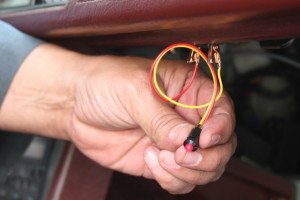 Welcome to the one if by land, two if by sea 50-in-1 electronic playground edition of the Tool of the Week. This time around we’re peering into computerized technology. The 1987 Mitsubishi Starion is a fuel injected car, but by no means modern. The transitional period between carburated and electronically injected engines produced some interesting if not cantankerous systems. The two-injector throttle body injection on the Starion falls into the island of misfit toys category, but the car is equipped with fully transistorized Electronic Control Unit. Any ECU made after 1995 can be accessed with a readily available universal engine code reader to help sort out check engine lights. The only people that had a Mitsubishi code reader back in 1987 were Mitsubishi (and Chrysler) dealerships. These machines were a few steps ahead of ENIAC, and about as expensive. Proving that you can learn and save money on the internets is the forum post that provided the knowledge to solder together this simple engine code reader from a two-dollar 12V LED and thirty-cent alligator clips from the local Radio Shack. Just find the pin outs and count the blinks.
Welcome to the one if by land, two if by sea 50-in-1 electronic playground edition of the Tool of the Week. This time around we’re peering into computerized technology. The 1987 Mitsubishi Starion is a fuel injected car, but by no means modern. The transitional period between carburated and electronically injected engines produced some interesting if not cantankerous systems. The two-injector throttle body injection on the Starion falls into the island of misfit toys category, but the car is equipped with fully transistorized Electronic Control Unit. Any ECU made after 1995 can be accessed with a readily available universal engine code reader to help sort out check engine lights. The only people that had a Mitsubishi code reader back in 1987 were Mitsubishi (and Chrysler) dealerships. These machines were a few steps ahead of ENIAC, and about as expensive. Proving that you can learn and save money on the internets is the forum post that provided the knowledge to solder together this simple engine code reader from a two-dollar 12V LED and thirty-cent alligator clips from the local Radio Shack. Just find the pin outs and count the blinks.
I’ve been meaning to whip one of those up myself. Much like your Starion, my Galant VR4s are pre-OBDII, meaning I get the same “luxury” of counting blinks or, should I go really old school, beeps from a buzzer device. If I get three dots alternating with three dashes…
On the Toyota 22RE (of my 2 4Runners), you’d short a connector in the engine compartment (with a parperclip) and read the blinks of the “check engine” light.
Early FE systems aren’t so bad. I’d positively terrified of anything from the earlier analog computer controlled carb era. 77-83, I’m looking at you…
I have an old tube powered oscilloscope that works well for this. I used to use it on my Galant. It is quite a bit heavier than a couple of wires and an LED, but the mad scientist factor is off the scale. Just gotta be careful picking the beast up.
Hey, that’s outright advanced. My LH-Jetronic version 2.2 only has the ability to report engine knock at either partial or full load in real time, and that only through the “wire-resistor-led-in-a-shaving-gel-cap” contraption I built. I’m with Mad_Science on those analog systems. Small moving parts + early computers seems like a very bad mix (ha!).
Turbobrick- funny you should say that, the LH 2.2 system on my 900 Turbo (’88) works just the same. Of course, us Saab snobs also have the APC system to manage boost. So fun to diagnose problems like this.